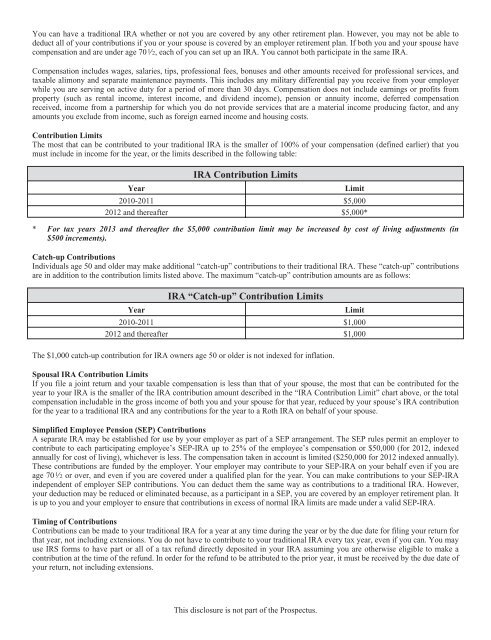Prudential Premier Retirement Variable Annuities
Prudential Premier Retirement Variable Annuities
Prudential Premier Retirement Variable Annuities
You also want an ePaper? Increase the reach of your titles
YUMPU automatically turns print PDFs into web optimized ePapers that Google loves.
You can have a traditional IRA whether or not you are covered by any other retirement plan. However, you may not be able to<br />
deduct all of your contributions if you or your spouse is covered by an employer retirement plan. If both you and your spouse have<br />
compensation and are under age 70 1 ⁄2, each of you can set up an IRA. You cannot both participate in the same IRA.<br />
Compensation includes wages, salaries, tips, professional fees, bonuses and other amounts received for professional services, and<br />
taxable alimony and separate maintenance payments. This includes any military differential pay you receive from your employer<br />
while you are serving on active duty for a period of more than 30 days. Compensation does not include earnings or profits from<br />
property (such as rental income, interest income, and dividend income), pension or annuity income, deferred compensation<br />
received, income from a partnership for which you do not provide services that are a material income producing factor, and any<br />
amounts you exclude from income, such as foreign earned income and housing costs.<br />
Contribution Limits<br />
The most that can be contributed to your traditional IRA is the smaller of 100% of your compensation (defined earlier) that you<br />
must include in income for the year, or the limits described in the following table:<br />
IRA Contribution Limits<br />
Year Limit<br />
2010-2011 $5,000<br />
2012 and thereafter $5,000*<br />
* For tax years 2013 and thereafter the $5,000 contribution limit may be increased by cost of living adjustments (in<br />
$500 increments).<br />
Catch-up Contributions<br />
Individuals age 50 and older may make additional “catch-up” contributions to their traditional IRA. These “catch-up” contributions<br />
are in addition to the contribution limits listed above. The maximum “catch-up” contribution amounts are as follows:<br />
IRA “Catch-up” Contribution Limits<br />
Year Limit<br />
2010-2011 $1,000<br />
2012 and thereafter $1,000<br />
The $1,000 catch-up contribution for IRA owners age 50 or older is not indexed for inflation.<br />
Spousal IRA Contribution Limits<br />
If you file a joint return and your taxable compensation is less than that of your spouse, the most that can be contributed for the<br />
year to your IRA is the smaller of the IRA contribution amount described in the “IRA Contribution Limit” chart above, or the total<br />
compensation includable in the gross income of both you and your spouse for that year, reduced by your spouse’s IRA contribution<br />
for the year to a traditional IRA and any contributions for the year to a Roth IRA on behalf of your spouse.<br />
Simplified Employee Pension (SEP) Contributions<br />
A separate IRA may be established for use by your employer as part of a SEP arrangement. The SEP rules permit an employer to<br />
contribute to each participating employee’s SEP-IRA up to 25% of the employee’s compensation or $50,000 (for 2012, indexed<br />
annually for cost of living), whichever is less. The compensation taken in account is limited ($250,000 for 2012 indexed annually).<br />
These contributions are funded by the employer. Your employer may contribute to your SEP-IRA on your behalf even if you are<br />
age 70 1 ⁄2 or over, and even if you are covered under a qualified plan for the year. You can make contributions to your SEP-IRA<br />
independent of employer SEP contributions. You can deduct them the same way as contributions to a traditional IRA. However,<br />
your deduction may be reduced or eliminated because, as a participant in a SEP, you are covered by an employer retirement plan. It<br />
is up to you and your employer to ensure that contributions in excess of normal IRA limits are made under a valid SEP-IRA.<br />
Timing of Contributions<br />
Contributions can be made to your traditional IRA for a year at any time during the year or by the due date for filing your return for<br />
that year, not including extensions. You do not have to contribute to your traditional IRA every tax year, even if you can. You may<br />
use IRS forms to have part or all of a tax refund directly deposited in your IRA assuming you are otherwise eligible to make a<br />
contribution at the time of the refund. In order for the refund to be attributed to the prior year, it must be received by the due date of<br />
your return, not including extensions.<br />
This disclosure is not part of the Prospectus.

















